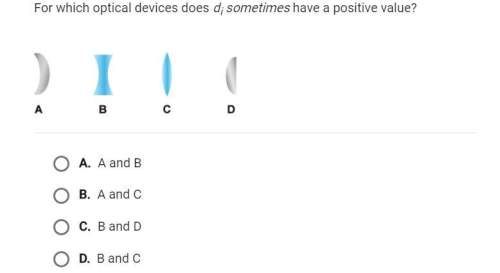When polarizing an object, what happens to the charges in the object?
a. they swirl about lik...

When polarizing an object, what happens to the charges in the object?
a. they swirl about like bees in a hive.
b. they separate, with positive charges on one side and negative
charges on the other.
c. the protons drain off, leaving the object negatively charged.
d. they repel each other and spread out all around the outer surface.

Answers: 1


Another question on Physics

Physics, 21.06.2019 23:20
Initially, a particle is moving at 5.33 m/s at an angle of 37.9° above the horizontal. two seconds later, its velocity is 6.11 m/s at an angle of 54.2° below the horizontal. what was the particle's average acceleration during these 2.00 seconds in the x-direction (enter first) and the y-direction?
Answers: 1

Physics, 22.06.2019 06:50
Much of the information taught in earth-space science would not be available if it weren’t for our remote sensing abilities. explain two ways our remote sensing strategies contribute to our knowledge of these topics.
Answers: 3

Physics, 22.06.2019 16:00
Fill in the blanks with the numbers is a measure of the resistance to flow. a high liquid has a high resistance to flow and flows slowly. the ancients thought everything in the world was made of 4 we now know that there are 94 naturally occurring and scientists have created another 24 i am certain they will create even more. honey flows slowly because it has a high to flowing. a can be separated by physical means because it contains more than one pure substance and 2 pure substances are not chemically bonded to each other. a cannot be separated by physical means. all matter is made up of all elements are with the same number of protons. if it is just a single or many bonded together, if all of them have the same number of protons, it is an element. in a piece of pure iron metal, all the are joined together, that piece of iron metal is called elemental iron. a single of iron is called elemental iron. a mixture has differences from place to place. we might need a microscope to see them or they might be obvious to the unaided eye. there are surfaces separating it into different phases. a mixture is the same everywhere. it is uniform. there are no surfaces separating it into different phases. if different kinds of atoms (different elements) are bonded together by their electrons, it is called a there are physical means of to isolate the different pure substances in a mixture and there are chemical means of to isolate the different elements in a compound. 1. element 2. compound 3. mixture 4. heterogeneous 5. homogeneous 6. pure substance 7. atoms 8. separation 9. viscosity 10. resistance
Answers: 3

Physics, 22.06.2019 16:40
Acapacitor is storing energy of 3 joules with a voltage of 50 volts across its terminals. a second identical capacitor of the same value is storing energy of 1 joule. what is the voltage across the terminals of the second capacitor?
Answers: 3
You know the right answer?
Questions

English, 06.05.2020 17:00

History, 06.05.2020 17:00

Mathematics, 06.05.2020 17:00


English, 06.05.2020 17:00

History, 06.05.2020 17:00



Mathematics, 06.05.2020 17:00

World Languages, 06.05.2020 17:00


Social Studies, 06.05.2020 17:00


Biology, 06.05.2020 17:00

Arts, 06.05.2020 17:00





English, 06.05.2020 17:01




